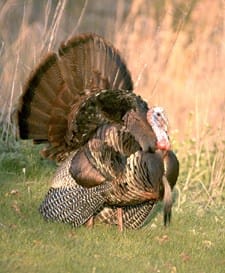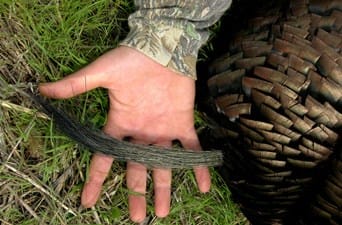By Joel D. Glover, reprinted from The Outdoor Wire

“I got a good 7-year-old bird,” the camo-clad hunter proudly stated when I asked if he’d had any luck. When I asked how he knew the age of the bird, I received a look of disdain and then he picked up the gobbler and thrust its legs toward me so I could examine a nice set of spurs. “Sharp as a tack” was all he said.
While it is generally accepted that spur length is a fairly reliable characteristic for determining the age of a gobbler, that only holds true until a turkey reaches about 3 years of age. Truthfully, aging a mature gobbler is a difficult task. While a juvenile gobbler – or “jake” – is fairly easy to identify based on his uneven tail fan, short beard and less than one-half-inch spurs, it becomes more difficult as a bird matures. Two-year-old gobblers are probably harvested at a higher rate than any other. This is often due to the fact that while they have mastered the ability to gobble and enjoy hearing themselves do it, they have not yet learned that every yelp doesn’t come from a turkey hen. The 2-year-old is often lured by the sweet tone of a well-chalked box or the quick cuts of a mouth call. The majority of these young gobblers will sport somewhat blunt spurs less than an inch long and beards around 9 inches.
Three-year-old birds typically have a beard around 10 inches long and pointed spurs of an inch or more. I hope you noticed the word “typically.” The truth is I’ve witnessed a mature adult turkey with a 4-inch beard and one with no beard whatsoever. I witnessed a 4-year-old known age bird with 5/8-inch spurs. I’ve harvested numerous mature gobblers that had no spurs or only one spur, and I’ve witnessed turkeys with multiple spurs on each leg.

Whenever dealing with wildlife, be very careful about using the words “never” or “always.” It was my good fortune to assist on a long-term turkey research project conducted on the Tallahala Wildlife Management Area in southern Mississippi. In addition to the volumes of data recorded during the study, we also made several interesting observations while trapping turkeys. I found it interesting that turkeys trapped and tagged as mature adults were later recaptured and found to have shorter spurs. In addition, one bird captured and tagged as a juvenile was harvested by a hunter the next year. Although the bird was less than 2 years old, it sported a set of sharp spurs that were 1.5-inches long!
Therefore, while body size, beard and spur length are usually fairly reliable for identifying birds as juveniles, exact age becomes much more of a mystery for adult turkeys once they’ve reached three years of age. The next time you have the privilege to take a wise old limb hanger, realize that it doesn’t really make any difference how old he was. Remember the words an old turkey hunter once told me: “They’re all good ones.”
Joel D. Glover is a Certified Wildlife Biologist with the Alabama Division of Wildlife and Freshwater Fisheries.







